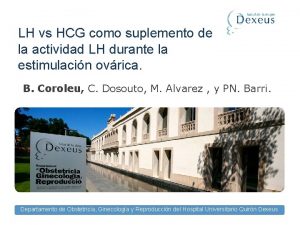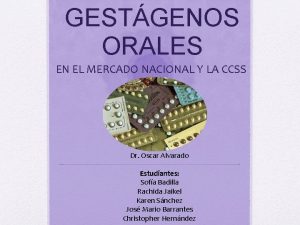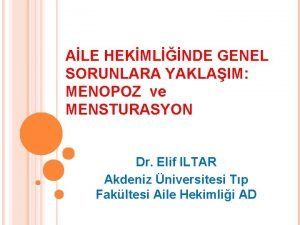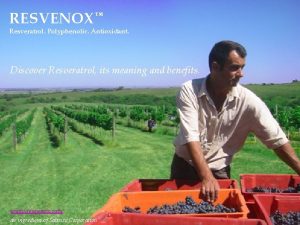Antioxidant Effects of 17 estradiol and Resveratrol on


- Slides: 2


Antioxidant Effects of 17 -β-estradiol and Resveratrol on Cardiovascular System n Diseases such as hypertension, coronary atherosclerosis, myocardial infarction leading to heart failure associated with cardiovascular system functional and structural changes. These include endothelial dysfunction, smooth muscle cell and cardiac fibroblast proliferation which resulting in cardiovascular remodeling. Cellular events underlying these processes involve changes in cardiovascular cells growth, apoptosis, migration, inflammation, and fibrosis. Many factors influence cellular changes, of which angiotensin II (Ang II) appears to be the most important. The physiological and pathophysiological actions of Ang II are mediated primarily via the Ang II type 1 receptor. Growing evidence indicates that Ang II induces its pleiotropic cardiovascular effects through NADPH-driven generation of reactive oxygen species (ROS). ROS function as important intracellular and intercellular second messengers to modulate many downstream signaling transduction and transcriptional factors, such as mitogen-activated protein kinase and activator protein-1 (AP-1). Induction of this signaling cascades leads to increases such as endothelin-1 (ET-1) gene expression and regulation of endothelial function, vascular smooth muscle cell growth and migration, and modification of extracellular matrix. ROS influence signaling molecules by altering the intracellular redox state. In physiological conditions, these events play an important role in maintaining cardiovascular function and integrity. Under pathological conditions ROS contribute to cardiovascular dysfunction and remodeling through oxidative damage. The following three studies focus on related issues. The first study investigated ROS in Ang II increases ET-1 gene expression and related intracellular mechanism in cardiovascular cells. Both of the subsequent two studies pursued the relationship of two natural antioxidants, one examining 17 -β-estradiol and the other study resveratrol, and the mechanisms by which they both singularly contribute to suppressing the signaling pathways and the ensuring beneficial antioxidant effect on the cardiovascular system. In the first part of the studies, we evaluated whether ROS are involved in Ang II-induced ET-1 gene expression, and the related intracellular mechanisms occurring within vascular endothelial cells. Cultured endothelial cells were stimulated with Ang II, and Northern blotting and a promoter activity assay examined the so-elicited ET-1 gene expression. Antioxidant pre -treatment of endothelial cells was performed prior to Ang II-induced extracellular signal-regulated kinase (ERK) phosphorylation in order to elucidate the redox-sensitive pathway for ET-1 gene expression. The ET-1 gene was induced with Ang II which was inhibited with AT 1 receptor antagonist (irbesartan). Ang II-enhanced intracellular ROS levels were inhibited by irbesartan and several antioxidants, and antioxidants suppressed Ang II-induced ET-1 gene expression. Furthermore, Ang II-activated ERK phosphorylation was also significantly inhibited by certain antioxidants. An ERK inhibitor, U 0126 inhibited Ang II-induced ET-1 expression completely. Co-transfection of the dominant negative mutant of Ras, Raf and MEK 1 (ERK kinase) attenuated the Ang II-enhanced ET-1 promoter activity, suggesting that the Ras-Raf-ERK pathway is required for the Ang II-induced ET-1 gene expression. Ang II-induced AP-1 reporter activities were inhibited by antioxidants. Moreover, mutational analysis of the ET-1 gene promoter showed that the AP-1 binding site was an important cis-acting element in Ang IIinduced ET-1 gene expression. Our first data suggest that ROS are involved in Ang II-induced ET-1 gene expression within endothelial cells. The redox-sensitive ERK-mediated AP-1 transcriptional pathway plays an important role in Ang II-induced ET-1 gene expression. In the second part of the studies we examine whether 17 -β-estradiol may alter Ang II-induced cell proliferation and identify the putative underlying signaling pathways in rat cardiac fibroblasts. Cultured rat cardiac fibroblasts were pre-incubated with 17 -β-estradiol then stimulated with Ang II, [3 H]thymidine incorporation and ET-1 gene expression were examined. The effect of 17 -β-estradiol on Ang II-induced NADPH oxidase activity, ROS formation, and ERK phosphorylation were tested to elucidate the intracellular mechanism of 17 -β-estradiol in proliferation and ET-1 gene expression. Ang II increased DNA synthesis, which was inhibited with 17 -β-estradiol (1– 100 n. M). 17 -β-estradiol, but not 17 -a-estradiol, inhibited the Ang IIinduced ET-1 gene expression as revealed by Northern blotting and promoter activity assay. This effect was prevented by co-incubation with the estrogen receptor antagonist ICI 182. 780 (1 μM). 17 -β-estradiol also inhibited Ang II-increased NADPH oxidase activity, ROS formation, ERK phosphorylation, and AP-1 -mediated reporter activity. In summary, our second results suggest that 17 -β-estradiol inhibits Ang II-induced cell proliferation and ET-1 gene expression, partially by interfering with the ERK pathway via attenuation of ROS generation. Thus, this study provides important new insight regarding the molecular pathways that may contribute to the proposed beneficial effects of estrogen on the cardiovascular system. In the third part of the studies, we examine whether resveratrol alters Ang II-induced cell proliferation and ET-1 gene expression and to identify the putative underlying signaling pathways in rat aortic smooth muscle cells. Cultured rat aortic smooth muscle cells were preincubated with resveratrol then stimulated with Ang II, after which [3 H] thymidine incorporation and ET-1 gene expression were examined. The intracellular mechanism of resveratrol in cellular proliferation and ET-1 gene expression was elucidated by examining the phosphorylation level of Ang II-induced ERK. The inhibitory effects of resveratrol (1– 100 μM) on Ang II-induced DNA synthesis and ET-1 gene expression were demonstrated with Northern blot and promoter activity assays. Measurements of 2’ 7’-dichlorodihydrofluorescin diacetate, a redox sensitive fluorescent dye, showed a resveratrol-mediated inhibition of intracellular ROS generated by the effects of Ang II. The inductive properties of Ang II and H 2 O 2 on ERK phosphorylation and AP-1 -mediated reporter activity were found reversed with resveratrol and antioxidants such as N-acetyl -cysteine. In summary, Our third results speculate that resveratrol inhibits Ang II-induced cell proliferation and ET-1 gene expression, which involves the disruption of the ERK pathway via attenuation of ROS generation. Thus, this study provides important insight into the molecular pathways that may contribute to the proposed beneficial effects of resveratrol on the cardiovascular system. In conclusion, our three in vitro studies all clearly indicate that Ang II-induced intracellular ROS act as second messengers and via redox-sensitive ERK-mediated AP-1 transcriptional pathway to stimulate the cell proliferation and ET-1 expression in various cardiovascular cells. Both 17 -β-estradiol and resveratrol have inhibitory effects on this signaling. These data strongly support the proposed beneficial antioxidant effects of 17 -β-estradiol and resveratrol in the cardiovascular system.



